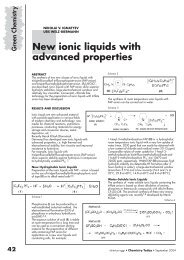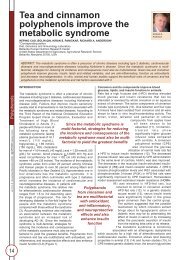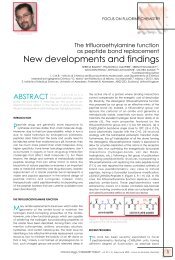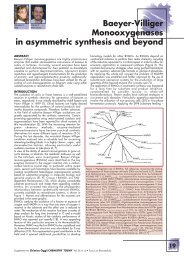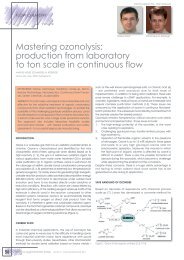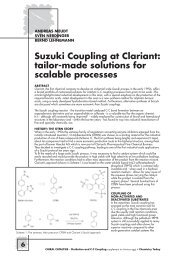Lake Como 2|4 October 2011 - CHIMICA Oggi/Chemistry Today
Lake Como 2|4 October 2011 - CHIMICA Oggi/Chemistry Today
Lake Como 2|4 October 2011 - CHIMICA Oggi/Chemistry Today
Create successful ePaper yourself
Turn your PDF publications into a flip-book with our unique Google optimized e-Paper software.
SPEAKER SPEAKER SPEAKER SPEAKER SPEAKER SPEAKER SPEAKER SPEAKER SPEAKER SPEAKER SPEAKER SPEAKER SPEAKER SPEAKER SPEAKER SPEAKER SPEAKER SPEAKER SPEAKER SPEAKER SPEAKER SPEAKER SPEAKER SPEAKER SPEAKER SPEAKER SPEAKER SPEAKER SPEAKER SPEAKER SPEAKER SPEAKER SPEAKER SPEAKER SPEAKER SPEAKER SPEAKER SPEAKER SPEAKER SPEAKER SPEAKER SPEAKER SPEAKER SPEAKER SPEAKER SPEAKER SPEAKER SPEAKER SPEAKER SPEAKER SPEAKER SPEAKER SPEAKER SPEAKER<br />
ABSTRACT<br />
BIOGRAPHY<br />
The advantages of continuous production<br />
of specialty chemicals enabled by fl ow chemistry<br />
Giorgio Giovanni Borghi<br />
Matric Europa - Italy<br />
Giorgio Giovanni Borghi<br />
A graduate of MIT and Padua University, after several years with Dow-Lepetit at the end of the<br />
seventies and early eighties, he has worked with many Italian and International engineering<br />
and contracting companies: Dravo Corporation Chemical Plants Division – Pittsburgh (US),<br />
GABOR Srl Inveruno (MI), b. e b. ingg. SpA - Milan, DAL Srl - Milan, DEVIN Srl - Milan, b. e b.<br />
impianti Srl - Milan, LAMCO Land Management Co. - Rome, Symi Progetti Srl - Bari, Intertecno<br />
S.p.A. - Milan.<br />
For most of these he has also been a member of the board.<br />
Since 2010 he is Managing Director of MATRIC Europa Srl, Italian subsidiary of<br />
MATRIC (Middle Atlantic Technology and Innovation Center) Charleston, WV<br />
(USA). MATRIC Europa carries out chemical process development and<br />
optimization with innovative enabling technologies.<br />
In the last 2 decades the world market share of countries which were leaders in production and export of APIS and specialty chemicals,<br />
Italy and Spain particularly, has shrunk considerably due to the growth of competitors from the BRIC community, i.e. India and China.<br />
Manpower accounts for a large share of the production costs, namely about 30% of the production costs for direct manpower and<br />
over 40% considering other accessory operations QA, QC, logistics, cleaning. Competitiveness of companies operating in this fi eld<br />
appears to be evermore dependent on their ability to fully exploit the benefi t of new technologies becoming available with an impact<br />
on the factors which are mostly affected by the difference in cost structure between Europe and its rapidly emerging competitors,<br />
lowering the incidence of manpower on total production costs. Continuous processes reduce the incidence of manpower on the unit<br />
product costs, and when linked to on-line real-time analytical platforms enable maintaining the process parameters in an operating<br />
window which ensures conformity of product quality to the required specifi cation. For this reason particular interest has been devoted<br />
in the last few years to those enabling technologies which aim at transforming batch processes into continuous processes and take<br />
advantage of the advances made in the fi eld of PAT and integrated process control for production of API and specialty chemicals.<br />
Advances in miniaturization technologies have widened the possibilities for development of microanalytical sensing and control<br />
platforms and PAT applications. The use of microreactors for continuous reactions enable carrying our multivariate studies in the lab<br />
in short time exploring new process windows, typically utilizing higher temperatures and pressures with respect to industrial processes<br />
with a very signifi cant impact on reaction times and selectivity, reducing the use of solvents, eliminating the need of costly transports<br />
and storages, as well as the purifi cation and recovery of the spent solvents. The optimized experimental system can then directly be<br />
transferred into production by a “numbering up” procedure, greatly reducing the engineering development time and the need of<br />
additional purifi cation steps to eliminate impurities which generally increase in scaling up chemical processes. Microreactors enable<br />
production of thousands of tons of product per year and thus virtually any API and most specialty chemicals of commercial interest.<br />
Other “enabling technologies” are being explored with the aim of linking them and making the complete processes continuous.<br />
Of particular interest are fi ltrations on selective membranes which are used both for purifi cation of the product and to shift the reaction<br />
equilibrium by continuously removing the product, and utilization of reactive membranes with immobilized catalysts and enzymes.<br />
Finally the ability to carry out high throughput experimentations producing large volumes of data have led to the development of<br />
sophisticated data handling and chemometric techniques and data fusion enabling linking complex raw material composition and<br />
process parameters to reaction yields. These developments show the potential for important future progress to be made which can<br />
enable an increase of competitiveness of European industries.<br />
8<br />
<strong>Lake</strong> <strong>Como</strong><br />
<strong>2|4</strong> <strong>October</strong> <strong>2011</strong>



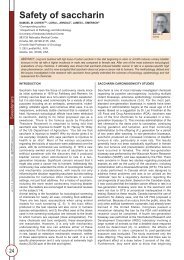
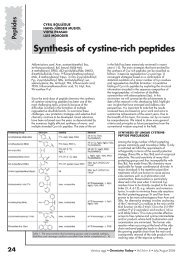
![Pietro Delogu [modalità compatibilità]](https://img.yumpu.com/12255149/1/190x135/pietro-delogu-modalita-compatibilita.jpg?quality=85)
